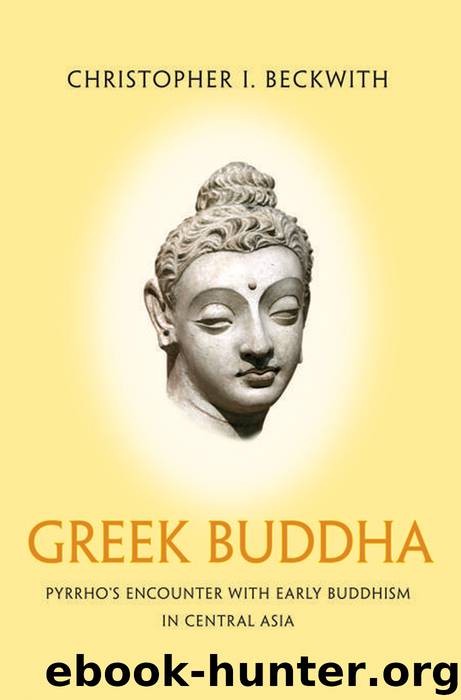Greek Buddha by Beckwith Christopher I

Author:Beckwith, Christopher I.
Language: eng
Format: epub
Publisher: Princeton University Press
Published: 2015-03-14T16:00:00+00:00
CHAPTER 4
Greek Enlightenment
WHAT THE BUDDHA, PYRRHO, AND HUME ARGUE AGAINST
The argument known in Antiquity as the Problem of the Criterion was introduced to Western thought by Pyrrho of Elis, who learned it in Central Asia and India from Early Buddhism, as shown in the Prologue and Chapter One. The problem revolutionized ancient European thought, such that from Pyrrho’s time onward ancient Graeco-Roman philosophy was focused on the epistemological question, “Can we really know anything?” The problem remained unsolved throughout Antiquity, but with the ascendancy of Christianity and its Aristotelian and Neoplatonic apologetics, it was sidelined and practically forgotten during the Middle Ages.
When Pyrrhonism was reintroduced to Western Europe in the late Renaissance, the problem once again revolutionized Western thought and shifted the central focus of philosophy to epistemology. The Scottish philosopher David Hume (1711–1776) is responsible for what may be called the problem’s modern incarnation, known today as the “Problem of Induction”,1 which he presents in his book, An Enquiry Concerning Human Understanding (henceforth Enquiry).2xi “Hume’s Problem” has been perhaps the most important single issue in Western philosophy in the two and a half centuries since his day. All of the major Western philosophers since Hume have grappled with it. Today it is generally considered “unsolvable”. However, this does not mean that it really is “unsolvable”—the idea is singularly inappropriate for it—especially in view of the fact that philosophers seem not to have appreciated the overwhelmingly important role of Pyrrhonism, which Hume actually trumpets throughout his book,3 not to speak of the crucial covert arguments that are presented in it. This chapter is devoted to analyzing these issues, which are fundamental to understanding not only Hume but also Pyrrho, and in turn the Buddha.
As shown in Chapter One, Pyrrho and the Buddha before him taught that things do not have their own absolute, inherent self-identities, or ‘differentiae’. Therefore, our minds provide them. They are often marked in speech by quality words, category words, and many others.4 For example, a child looks out the window and sees an animal. What is it? Because things do not have their own inherent differentiae, the animal does not have a little sign or label growing in its fur that spells out its genus, species, and so on, for our benefit. Accordingly, she applies her stored knowledge about things and matches the animal up: it’s a “bunny”. So far, so good. But did she get this category, BUNNY, and all the things she knows about bunnies, from logic, from pure deductive thinking? No, she got it from induction—from observing bunnies, or from seeing pictures of them and being told about them. Because our knowledge about the world comes from the world, it is perfectly circular. “Since induction is a contingent method—even good inductions may lead from truths to falsehoods—there can be no deductive justification for induction. Any inductive justification of induction would, on the other hand, be circular.”5 This is the Problem of Induction.
The problem is connected to the ancient Problem of the Criterion introduced by Pyrrho.
Download
This site does not store any files on its server. We only index and link to content provided by other sites. Please contact the content providers to delete copyright contents if any and email us, we'll remove relevant links or contents immediately.
| Africa | Americas |
| Arctic & Antarctica | Asia |
| Australia & Oceania | Europe |
| Middle East | Russia |
| United States | World |
| Ancient Civilizations | Military |
| Historical Study & Educational Resources |
Mythos (2019 Re-Issue) by Stephen Fry(1519)
Alexander the Great by Robin Lane Fox(1327)
On Sparta (Penguin Classics) by Plutarch(1157)
Antigone Rising: The Subversive Power of the Ancient Myths by Helen Morales(1114)
Persian Fire by Tom Holland(1048)
The Last Days of Socrates by Plato & Christopher Rowe & Plato(990)
The Classical World: An Epic History From Homer to Hadrian by Robin Lane Fox(979)
Cicero by Anthony Everitt(952)
The Athenian Constitution (Classics) by Aristotle(912)
Antigone Rising by Helen Morales(814)
The Greek World(794)
The Riddle of the Labyrinth(776)
The Story of the Greeks (Yesterday's Classics) by Guerber H. A(759)
The End of the Bronze Age by Robert Drews;(722)
The Eudemian Ethics (Oxford World's Classics) by Kenny Anthony(721)
The Homeric Hymns (Penguin Classics) by Homer(713)
Guide to Greece by Pausanias(696)
Lords of the Sea: The Epic Story of the Athenian Navy and the Birth of Democracy by John R. Hale(690)
A History of My Times (Classics) by Xenophon(667)
